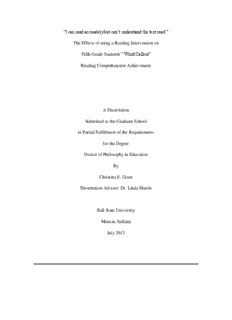Table Of Content“I can read accurately but can’t understand the text read:”
The Effects of using a Reading Intervention on
Fifth-Grade Students’ “Word Callers”
Reading Comprehension Achievement
A Dissertation
Submitted to the Graduate School
in Partial Fulfillment of the Requirements
for the Degree
Doctor of Philosophy in Education
By
Christina E. Grant
Dissertation Advisor: Dr. Linda Martin
Ball State University
Muncie, Indiana
July 2013
“I can read accurately but can’t understand the text read:”
The Effects of using a Reading Intervention on
Fifth-Grade Students’ “Word Callers”
Reading Comprehension Achievement
A Dissertation
Submitted to the Graduate School
in Partial Fulfillment of the Requirements
for the Degree
Doctor of Education
By
Christina E. Grant
Dissertation Advisor: Dr. Linda Martin
APPROVED BY:
____________________________________ _______________
Dr. Linda Martin, Committee Chair Date
____________________________________ _______________
Dr. Diane Bottomley, Department Representative Date
____________________________________ _______________
Dr. David McIntosh, Cognate Representative Date
____________________________________ _______________
Dr. W. Holmes Finch, Cognate Representative Date
____________________________________ _______________
Dr. Marilynn Quick, At-Large Member Date
____________________________________ _______________
Dean of the Graduate School Date
BALL STATE UNIVERSITY
MUNCIE, INDIANA
July 2013
Copyright © Christina E. Grant 2013
All Rights Reserved
Acknowledgements
To the fifth-grade “word callers,” you serve as a constant reminder of why I entered this
teaching profession. Thank you for allowing me to learn in your environment and for
providing me with great insight into the world of reading.
Dr. Linda Martin, thank you for chairing my committee, meeting with me weekly, and
reading countless drafts. Your warmth and encouragement means more to me than words
can express. Dr. Diane Bottomley, thank you for sharing your knowledge and passion for
Reciprocal Teaching. Dr. David McIntosh, thank you for your support and assistance
throughout. Dr. W. Holmes Finch, thank you for guiding me through the analysis.
To my husband, Jerrod, you are a constant source of inspiration. Your never-ending
support made this journey possible. I love you whole-heartedly.
To my parents, Jim and Kay Kreftmeyer, thank you for giving me a childhood that
instilled a love of learning and for being exemplary role models.
TABLE OF CONTENTS
Page
ACKNOWLEDGEMENTS………………………………………………………...iv.
LIST OF TABLES………………………………………………………………….viii.
LIST OF FIGURES…………………………………………………………………ix.
ABSTRACT………………………………………………………………………...x.
CHAPTER I: INTRODUCTION…………………………………………………...11
Context………………………………………………………………………11
Statement of Problem………………………………………………………..13
Purpose of Study…………………………………………………………….14
Research Question …………………………………………………………..14
Research Sub-questions……………………………………………………...14
Definition of Terms…………………………………………………………,14
Significance of Study………………………………………………………..16
Assumptions of Study……………………………………………………….16
Summary…………………………………………………………………….17
CHAPTER II: REVIEW OF RELATED LITERATURE…………………………..19
Theory Relevant to Research Question……………………………………...22
Fluency……………………………………………………………………....25
Reading Comprehension Strategies…………………………………………26
Teaching Reading Comprehension Strategies………………………………27
Multiple Reading Comprehension Strategies……………………………….30
Text Structures……………………………………………………………....36
Scaffolding…………………………………………………………………..37
Modeling…………………………………………………………………….39
Metacognition……………………………………………………………….40
Think-Alouds………………………………………………………………..42
Not the Typical Average Reader……………………………………………45
“Word Callers”……………………………………………………………...45
What Reading Comprehension Should Be Going On Now In Classrooms!..48
Summary…………………………………………………………………….50
CHAPTER III: PROCEDURES…………………………………………………….52
Method………………………………………………………………………53
Reciprocal Teaching……….………………………………………………..53
Setting and Participants……………………………………………………...58
Measuring Reading Comprehension Strategies……………………………...60
Measures……………………………………………………………………..61
Assessments………………………………………………………………….62
Procedures…………………………………………………………………....66
Analysis……………………………………………………………………....74
CHAPTER IV: RESULTS……………………………………………………………78
Research Results………………………………………………………………79
Summary………………………………………………………………………90
CHAPTER V: SUMMARY AND CONCLUSION………………………………......91
Overview of the Study…………………………………………………………91
Findings and Interpretations……………………………………………….......92
Limitations…………………………………………………………………..97
Educational Implications…………………………………………………...101
Recommendations for Future Research…………………………………….106
Conclusions…………………………………………………………………109
REFERENCES……………………………………………………………………...111
APPENDICES
APPENDIX A: Who is a “Word Caller” Handout…………………………126
APPENDIX B: Parent Consent Letter……………………………………...129
APPENDIX C: Sample Lesson from Experimental Group Teacher……….132
APPENDIX D: Fidelity Self-checklist/Sample Lesson from………………135
Control Group Teacher
APPENDIX E: Observational Fidelity Checklists………………………….137
APPENDIX F: Parent Letter and Feedback Chart………………………….139
APPENDIX G: Reflective Interview Protocol……………………………...142
LIST OF TABLES
Page
Table 1………………………………………………………………………………70
The distribution of the “word callers” among the three participating
schools
Table 2……………………………………………………………………………….74
Research Questions, Dependent Measures, and Analyses
Table 3…………………………………………………………………………….…76
Student Reading A-Z reading comprehension levels and conversion
scores
Table 4……………………………………………………………………………….79
Mean scores for Reading A-Z reading comprehension levels
Table 5……………………………………………………………………………….80
Results of repeated measures ANOVA analysis considering the time
of the interaction and group
Table 6………………………………………………………………………………83
Mean scores for Metacognition Survey
Table 7………………………………………………………………………………85
Reading comprehension strategies used by students across the groups
during pre-and post-testing
Table 8………………………………………………………………………………89
Results of Univariate Analysis of Covariance analysis considering group
LIST OF FIGURES
Page
Figure 1……………………………………………………………………………..54
Reciprocal Teaching Strategy Definitions
Figure 2……………………………………………………………………………..81
Reading A-Z reading comprehension level group comparison
Figure 3……………………………………………………………………………..83
Metacognition Survey score group comparison
Figure 4……………………………………………………………………………..85
Reading comprehension strategy use by students during pre-and
post-testing comparison
ABSTRACT
The purpose of this study was to determine the effects of an intervention of five
researched reading strategies on fifth-grade students’ “word callers” reading
achievement. Twenty-one fifth-grade students attending elementary schools in mid-
western United States participated in this study. Students were randomly assigned to
either the experimental group or the control group. The students in the experimental
group received 50 minutes of small-group intervention, twice weekly, after-school, for 12
weeks focusing on the use of five research-based reading comprehension strategies. The
control group received 50 minutes of small-group intervention, twice weekly after-school
for 12 weeks, focusing on Common Core reading curriculum. Triangulation of data
sources was achieved through analysis of the running records including comprehension
retelling and answering of questions, a metacognition survey, an oral fluency rater scale,
observational notes, and a reflective interview protocol on students’ strategy use.
General findings included statistically significant changes in reading comprehension
levels in all students (control and experimental) who participated in the after-school
reading intervention. Importantly, statistically significant changes began to take place in
“word callers” in the 12-week study. This was seen in their overall reading
comprehension levels, and ability to report comprehension strategies and apply them to
their reading. In summary, an after-school intervention explicitly using the Reciprocal
Teaching model plus visualizing appears to play a large role in helping “word callers”
improve their reading comprehension ability.
Description:Student Reading A-Z reading comprehension levels and conversion scores . and complex social differences, where the student is, at times, expected.

